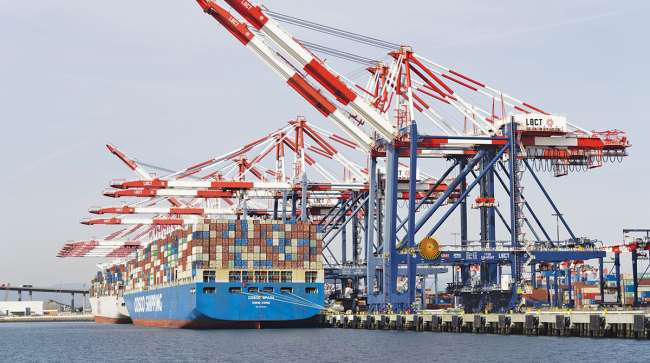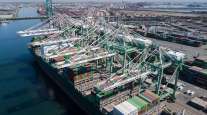September Container Volume Shows Ports on Rebound

[Stay on top of transportation news: Get TTNews in your inbox.]
Two of the nation’s largest ports on the Pacific Coast bounced back in September with strong container volume numbers.
The Port of Los Angeles posted a 5.4% year-over-year increase, moving 748,440 20-foot-equivalent containers compared with 709,873 a year ago.
“September was another good month, with imports up 14% and exports jumping 55%,” Executive Director Gene Seroka said. “Exports are trending up, and that’s good news because narrowing the trade gap boosts the U.S. economy. With the long-term dockworker contract in place, we’re seeing more cargo shifting back to Los Angeles. The table is set to scale up as demand increases.”
In late June, the Pacific Maritime Association and the 22,000-member International Longshore and Warehouse Union reached a six-year deal, which port officials on the West Coast said will bring labor stability.
For the second consecutive month, Port of Los Angeles cargo volume increased compared to 2022. The Port handled 748,440 Twenty-Foot Equivalent Units (TEUs) in September, a 5.4% improvement compared to the same period last year.https://t.co/bHftoIVbU1 pic.twitter.com/4vZaozEo6G — Port of Los Angeles (@PortofLA) October 23, 2023
The adjacent Port of Long Beach reported its strongest September on record, processing 829,429 containers, up 11.8% from the same month in 2022, and it marked the port’s first monthly year-over-year cargo increase in 14 months.

Port of Los Angeles Executive Director Gene Seroka (left), Port of Long Beach Executive Director Mario Cordero
Port Executive Director Mario Cordero told Transport Topics stronger consumer demand for holiday goods, the new labor contract and ongoing marketing efforts to showcase the facility are paying dividends.
“I am very pleased,” he said. “We’re back to normal in terms of how we operate. So now the supply chain is much better than it was a year ago. We’re looking forward to a moderate rebound in cargo volume through the end of the year.”

Brandes
The Port of Oakland reported a 6.9% year-over-year decline in container volume, processing 171,822 TEUs compared with 184,729 in 2022. Month-to-month volume dipped 7%.
“The Port of Oakland current container volume is consistent with the leveling off of global container traffic,” Maritime Director Bryan Brandes said. “Vessel calls to the port have increased this year, pointing to a slow and steady recovery from the turmoil of the past couple of years.”
Look what's coming to the TraPac terminal at the Port!#ports #decarbonization #airquality https://t.co/RsASTaZzn1 — Port of Oakland (@PortofOakland) October 27, 2023
Meanwhile, the Port of Oakland announced it is in line for federal and state funding as part of a national, multibillion-dollar effort to create regional hydrogen fueling hubs. The port’s specific share of the funding is expected to be announced later this year.
The dual port complexes at Seattle-Tacoma, Wash., processed 15.5% more containers in September year-over-year. Some 319,609 TEUs were processed at those facilities compared with 285,315 in 2022.
Officials said the September volumes were the highest monthly total so far this year at the ports and that consistent vessel arrivals along with increased intact intermodal rail volumes led to the strong performance.
Despite the ebbs and flows of the global economy, we remain committed to investing in our terminal infrastructure.
Port Houston Executive Director Roger Guenther
Image
Port Houston reported an 8% decline, processing 325,588 TEUs compared with 353,524 in the year-ago period.
“Like many ports across the country, Port Houston has seen an expected decline in container import volumes compared to the remarkable numbers seen in 2022,” Executive Director Roger Guenther said. “Despite the ebbs and flows of the global economy, we remain committed to investing in our terminal infrastructure to meet growing demand.”
The facility is in the midst of several infrastructure projects, including $1 billion for deepening and widening the Houston Ship Channel, which officials say will be finished in 2025.
The Port of Virginia is making progress in its effort to become the primary logistics center for the Mid-Atlantic’s growing offshore-wind energy industry as the port today debuted the first shipment of components for @DominionEnergy's CVOW project at Portsmouth Marine Terminal. pic.twitter.com/kZunKOOy7z — The Port of Virginia (@PortofVirginia) October 27, 2023
The Port of Virginia reported a 13.2% year-over-year decline in container volume as it processed 270,979 TEUs compared with 312,230 in September 2022. The facility is in the early stages of a multimillion-dollar plan to become the primary logistics center for the mid-Atlantic’s growing offshore wind-energy industry.
The Port of Charleston reported a 12.1% decline in container volume, handling 199,208 TEUs in September compared with 226,807 a year ago. A new report commissioned for the South Carolina Ports Authority by the University of South Carolina Darla Moore School of Business shows the state’s marine terminals and inland facilities generate $86.7 billion in economic impact and support 260,000 jobs.
The report said the economic output equals 10.1% of the state’s total annual gross product.
“Having a well-run port system and rail-served inland ports in South Carolina attracts port-dependent businesses to invest in our state and create new jobs,” port CEO Barbara Melvin said.
Georgia Ports Authority is showing truckers the appreciation they deserve at the Port of Brunswick. The truck drivers were welcomed with a chicken biscuit and a new safety vest this morning. We thank them for all that they do to keep America moving.#ThankATrucker #supplychain… pic.twitter.com/bIiwN2sxzz — Georgia Ports (@GaPorts) October 19, 2023
The Port of Savannah did not have container numbers available at press time, but the Georgia Ports Authority on Oct. 26 filed an amicus brief with the U.S. Supreme Court saying its longtime business model and plans to add a nearly 400-acre terminal by 2030 are jeopardized if the International Longshoremen’s Association is allowed to sue ocean carriers that call on marine terminals that use nonunion labor. The port said changing its hybrid labor model to an all-union facility would cost the port an estimated $600 million in the first year.
The Port Authority of New York and New Jersey reports container numbers one month later than other facilities. In August, its numbers dropped 21.4% to 662,740 TEUs compared with 843,191 in 2022.
Want more news? Listen to today's daily briefing below or go here for more info:





